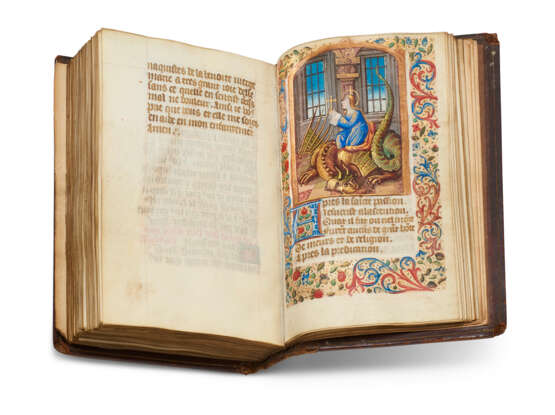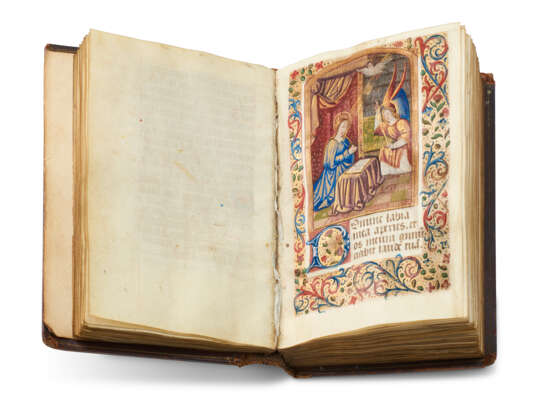ID 794414
Лот 35 | Workshop of the Master of Etienne Poncher (fl. first decades 16th century)
Оценочная стоимость
£ 10 000 – 15 000
The Hours of Nicole Bourguette, use of Reims, in French and Latin, illuminated manuscript on vellum [Reims, first decade 16th century].
A highly personalised Book of Hours with numerous and unusual prayers in the French vernacular selected by its original owner Nicole Bourguette, charmingly illuminated in the style of the Master of Etienne Poncher, and later owned by the Comte d’Antraigues, the diplomat-spy who was dramatically assassinated by a disgruntled Italian servant.
182 x 130mm. iii (paper) +ii+144+ii+iii (paper), complete, collation: 1-38, 43 (of 4, i a cancelled blank), 5-88, 94, 10-168, 1710, 18-198, 20 lines, ruled space: 126 x 75mm, illuminated initials in gold on red and blue grounds throughout, rubrics in red, 4 large miniatures within a full border, 11 historiated initials with one-sided borders (occasional fading, thumbing and marginal staining, a few smudges and small losses of pigment, e.g. to the forehead of the Virgin on f.28 or to the face of Christ on f.64). 19th-century brown calf tooled in gold, title on spine and date ‘1593’ gilt (edges scuffed, spine cracked and detaching from text block).
Provenance:
(1) Nicole Bourguette: her ownership inscription on f.144v: ‘Ceste p[rese]nte heures app[ar]tie[n]ne[n]t a Nicole Bourguette’. The inscription is in the same hand as the rest of the manuscript, so Nicole was presumably the original owner. The almanac for the years 1508-20, the liturgical use of the Offices of the Virgin and of the Dead and St Remy in the calendar and Litany, indicate that the manuscript was produced in Reims in the first decade of the 16th century. The selection of unusual prayers, mostly in French (one to ward off thunder, one for working and pregnant women, and another with a lengthy explanatory rubric regarding Canon Arnoul’s vision of the Virgin), and the Life of St Margaret (ff.129-144v), must point to Nicole’s own interests and affinities.
(2) Sister Perrette Renault: her inscription in a 16th-century hand ‘Ses ditz heures m’ont estes venduz a moy sœur perrette renault religieuse de St Claire au Cordelliers’. This is likely the Clarissan Monastery of Sainte-Claire de Reims, founded in 1220.
(3) H. Baillia: ownership inscription, initialled: ‘Qui me les a donnez le jour et an souscrits / le 27 mars 1593. H Baillia. H.B. ’
(4) Later, ?17th-century inscription ‘Cardunes’ at the foot of the page on f.144v.
(5) Jules Pierre Antoine Emmanuel de Launay d’Antraigues (b.1792), of 27 Montague Place: ownership note in English signed ‘J.S.’ on the third paper flyleaf recounting how the book had been received on 24 July 1814 from the son of Louis-Alexandre de Launay, comte d'Antraigues (1753-1812), French pamphleteer, diplomat, spy and political adventurer during the French Revolution and Napoleonic Wars, who was assassinated with his wife at 27 Barnes Terrace either by a disgruntled Italian servant, or for political motives. The son is presumably Jules, comte d’Antraigues whom Jane Austen mentions in one of her letters to her sister Cassandra after a visit to tea at the d’Antraigue’s home in 1811. Most of his library was sold at auction in 1817.
(6) Near-illegible notes in an early 20th-century English hand in pencil on the second paper flyleaf, beneath a sale catalogue clipping, where the present manuscript is no 81.
(7) Sotheby’s, 18 July, 1949, lot 275.
Content: Almanac for 1508-1520 and Calendar ff.1-7v; blank f.8; ‘O Royne qui fustes mise et assise’, in French, ff.9-12; prayer to one’s own guardian angel and to St Michael Archangel, in Latin, ff.12-13; prayers, in French, including: to Jesus, the Our Father, the Hail Mary, the Credo, the Ten Commandments, the Five Commandments of the Church, the ‘three truths’ to save one’s soul (beginning: ‘Mon Dieu, mon redempteur, par ta clemence infinite […]’), to St Gregory, ff.13-17v; prayers, in Latin, to the Holy Spirit and St Fiacre ff.17v-18v; Douce Dame, and indulgences, in French and Latin, ff.18v-22v; Salve Regina, ff.23-23v; prayers, in French, to be said during Mass, against thunder, to one’s guardian angel and to God ff.23v-26; Gospel extract ff.26-27; Hours of the Virgin, use of Reims, ff.28-62v: matins f.28, lauds f.36, prime 43v, terce 47v, sext (‘Midi’) f.50, none f.52v, vespers f.55, compline f.59v; blank f.63; Seven Penitential Psalms and Litany ff.64-76v; blank f.77; Office of the Dead, use of Reims, ff.78-107; Hours of the Cross, in French, ff.107v-109; the 7 verses of St Bernard ff.109-110; the 15 Joys of the Virgin and Seven Requests to Our Lord, in French, ff.110-116v; ‘Missus est Gabriel’, preceded by a long rubric in French telling how it was revealed by the Virgin to a canon called Arnoul, and a prayer for confession, ff.116v-127; prayers to be said by working and pregnant women ff.127-128v; Life of St Margaret, in French, ff.129-144v.
The content of the present Hours is highly personalised and shows an extremely unusual preponderance of prayers and texts in the vernacular. Among these, ‘O Royne qui fustes mise et assise’, attributed to Guillaume Alexis, survives in thirty-odd manuscripts of the 15th and 16th centuries (see J. Sonet, Répertoire d'incipit de prières en ancien français, 1956, no 1804). The lengthy rubric with the tale of Arnoul introducing the ‘Missus est Gabriel’ appears in around 300 manuscript Books of Hours described by Leroquais (e.g. Paris, Bibliothèque nationale de France, Latin 1168, for the use of Châlons-sur-Marne; Latin 1411, for the use of Rouen; and Latin 13285, for the use of Sarum; see Leroquais, Les livres d’Heures manuscrits de la Bibliothèque nationale, Paris, 1927, I, pp.95 and 250, II, pp.28-29). The Hours of the Cross in French, beginning ‘Jhesucrist, a matines fut vostre char vendue / A prime de crachie en la face batue’ (J. Sonet, Répertoire d'incipit de prières en ancien français, 1956, no 934) appears, according to Jonas (Répertoire des textes et des manuscrits médiévaux d'oc et d'oïl) in 24 manuscripts. The Life of St Margaret, opening ‘Apres la sainte passion /Jesuchrist a l'ascencion’ survives in some 78 Books of Hours.
Illumination:
The miniatures in the present manuscript are in the style of the Master of Étienne Poncher, named after the French prelate, diplomat and bishop of Paris for whom the Master produced a Pontifical (Bibliothèque nationale de France, lat.956) and a second manuscript entitled Les empereurs de Rome et les roys de France (see I. Delaunay, Échanges artistiques entre livres d’heures manuscrits et imprimés produits à Paris vers 1480-1500, 2000, pp.289-310). Characteristic features of his style are the strong-nosed, ruddy-cheeked, fluffy-bearded old men and the snowy-skinned female figures with lips dotted in red.
The subjects of the full-page miniatures are as follows: Annunciation f.28, Crucifixion f.64; Pieta f.78, St Margaret f.129.
The subjects of the historiated initials are as follows: Virgin of the Apocalypse f.9, Visitation f.36, Nativity f.43v, Annunciation to the Shepherds f.47v, Adoration of the Magi f.50, Presentation in the Temple f.52v, Flight into Egypt f.55, Coronation f.59v, Christ carrying the cross f.107v, Virgin in prayer f.110, God blessing f.114.
Special notice
No VAT on hammer price or buyer's premium.
| Место происхождения: | Западная Европа, Франция, Европа |
|---|---|
| Категория аукционного дома: | Манускрипты Средневековья и Ренессанса |
| Место происхождения: | Западная Европа, Франция, Европа |
|---|---|
| Категория аукционного дома: | Манускрипты Средневековья и Ренессанса |
| Адрес торгов |
CHRISTIE'S 8 King Street, St. James's SW1Y 6QT London Великобритания | |
|---|---|---|
| Предосмотр |
| |
| Телефон | +44 (0)20 7839 9060 | |
| Комиссия | see on Website | |
| Условия использования | Условия использования |






